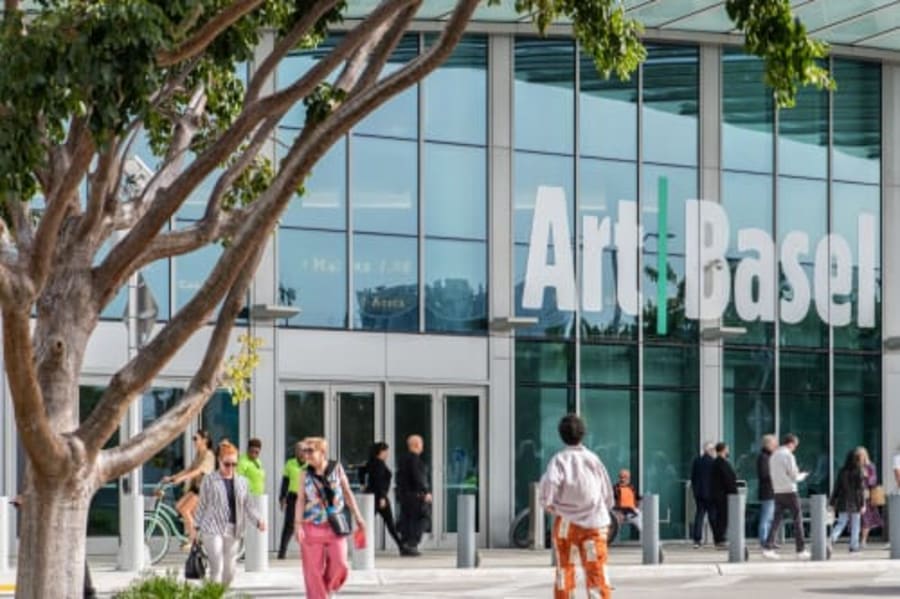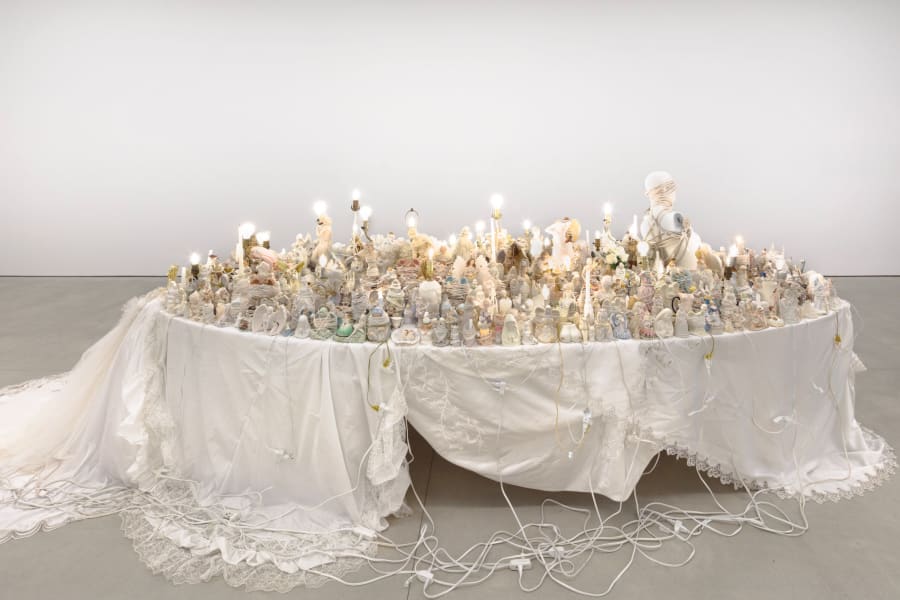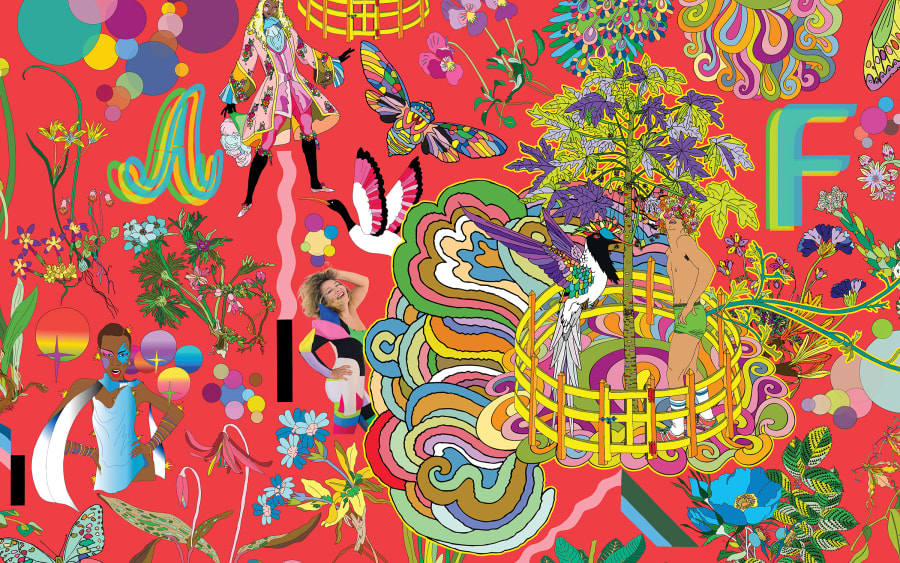The emerging artists at this year’s Art Basel Miami Beach are a testament to the possibilities of contemporary practices to produce not only riveting art but also fascinating research in media ranging from metalwork to textiles to light installation. The following artists are just a few to look out for in the Positions sector of the fair.
For her project shown by Piedras (Buenos Aires), multidisciplinary artist Jimena Croceri (b. 1981, Argentina) has crafted nine organically shaped solid sculptures from copper, bronze, and aluminum. Each piece is molded to fill a bodily cavity, such as the clavicle, or the unique hollows created when two or more figures touch. Shown alongside photographic documentation that illustrates their creation, the sculptures reference the use of adornments for talismanic power in pre-Columbian Andean culture – and what they might do for bodies today.
Expanding on his maximalist sculptural practice, Terrence Musekiwa (b. 1990, Zimbabwe) will present new work at Catinca Tabacaru Gallery (Bucharest) that includes traditionally carved stone heads atop figures made with found objects, such as bullet casings and nitrous oxide canisters. This approach represents Musekiwa’s interest in blending contemporary ecological concerns with ancestral artistic knowledge and reflects his research into the human and geological material histories of Zimbabwe.
Randolpho Lamonier (b. 1988, Brazil) and Dina Danish (b. 1981, France) explore similar themes of social history but through textiles. At Verve (São Paulo), Lamonier sews and embroiders on rugs and carpets to create hanging tapestries that confront viewers with often violent realities. The embroidered assemblages include micro- and macro-political messages – figures gunned down, dark and jumbled cityscapes, fire-breathing activists – that draw a direct line between private and public in Brazil.
Danish, meanwhile, renders images from mass media in textiles, driven by her research into the use of the applique stitch by Egyptian tentmakers for ornamental banners. Gypsum (Cairo) will show a series of large-scale, hand-stitched tapestries by the artist, who was raised in Cairo, that portray widely broadcasted political moments, such as Prince Charles performatively signing the document that made him king in 2022. Danish removes the subject’s faces, highlighting the Islamic patterning of the background instead. Such blending – of Egyptian and Western, the mediated image and traditional craftsmanship – evokes a humorous and sly questioning of the binaries that structure society.
A less mediated political encounter is the focus of dancer and choreographer Diego Vega Solorza (b. 1990, Mexico). Solorza was raised in Sinaloa, an area of northern Mexico racked by violence; his difficult personal history has become a thematic line sustaining his practice. Solorza's presentation with LLANO (Mexico City) centers around a sculpture of a custom, double horse saddle crafted in black leather with metal detailing. Accompanying the sculpture are videos and photographs featuring people in rancher attire typical for men in Sinaloa but engaged in repetitive dances and gestures that examine – and undermine – macho constructions of masculinity.
Elsewhere, a sculptural installation by Jesse Stecklow (b. 1993, United States), presented by Sweetwater (Berlin), has no trace of the human. Instead, it focuses on the intersecting flows of data, light, and time. A series of lightbulbs coated in beeswax will be installed along the bottom edge of the booth walls, partly an homage to Felix Gonzalez-Torres’s Untitled (Go-Go Dancing Platform) (1991). A separate work located on the wall – a faceless sundial – will contain an air-sampling device, and the chemical contents of the air will be analyzed by a lab after the fair. On the floor, two sculptures integrate different aspects of these works for an intriguing coalescence of light and timekeeping.
For her presentation with Espacio Continuo (Bogotá), Rosario López (b. 1970, Colombia) researched the archeological efforts carried out at a site called Monsú in the suburbs of Cartagena, where ancient pictograms and artifacts were found, and also conducted interviews with people currently living in the area – all of which informed the creation of a new series of tapestries, embroidered maps, and ceramics. Two monumental tapestries, for example, portray the geological layers of an excavation, while a sculpture of a local snail species alludes to the fragility of the ecosystem.
Referencing heritage and memory, the paintings of Maya Kaqchikel artist Paula Nicho Cúmez (b. 1955, Guatemala), which were included in this year’s Venice Biennale, will be shown at Art Basel Miami Beach by Proyectos Ultravioleta (Guatemala). Pulling from dreams to create tableaus that draw connections between humans, the land, animals, and the spiritual world, Cúmez often paints natural landscapes peopled by female figures that sometimes become the mountains. The vibrant, traditional Maya patterns of their clothing also often become their skin, a nod to Cúmez’s memory of not being allowed to wear Indigenous clothing to school as a child. Growing up, the artist resisted the traditional genre painting of her hometown; these works, too, challenge the history of colonialism and present-tense oppression.
Art Basel Miami Beach will take place from December 6 to 8, 2024. Learn more here.
Rob Goyanes is a writer and editor from Miami, Florida. His work has appeared in BOMB, e-flux journal, Los Angeles Times, and elsewhere. He lives in Los Angeles, California.
Published on November 8, 2024.
Caption for header image: Dina Danish, The Royal Declaration, 2024. Courtesy of the artist and Gypsum.


